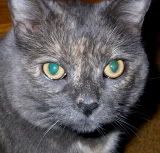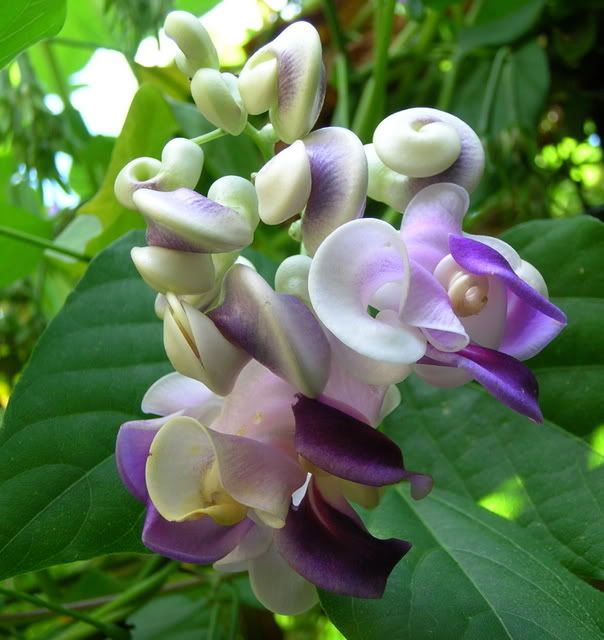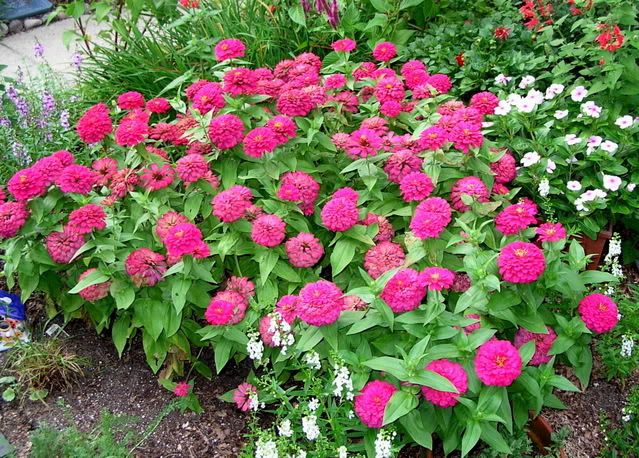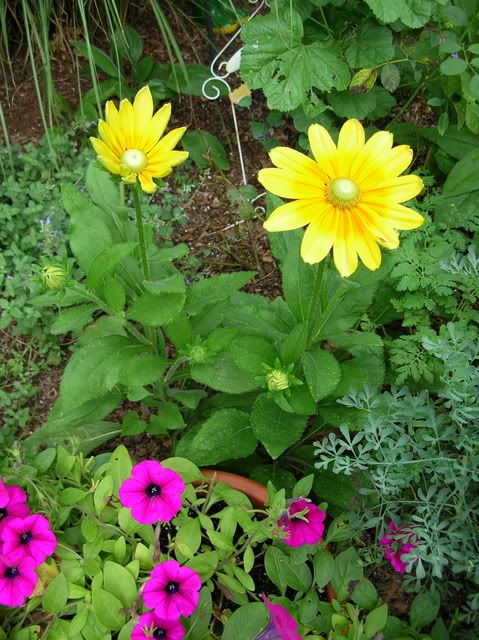
 “Rain drops on roses and whiskers on kittens”, of course. They go without saying. “Bright copper kettles” , however, are too time-consuming to keep shiny, and these days I prefer polartec gloves instead of “Warm woolen mittens”. But when it comes to “Brown paper packages tied up with strings"……those definitely are "A few of my favorite things". Especially if those brown paper packages contain seeds of favorite flowers that I’ve collected from my garden at the end of the season.
“Rain drops on roses and whiskers on kittens”, of course. They go without saying. “Bright copper kettles” , however, are too time-consuming to keep shiny, and these days I prefer polartec gloves instead of “Warm woolen mittens”. But when it comes to “Brown paper packages tied up with strings"……those definitely are "A few of my favorite things". Especially if those brown paper packages contain seeds of favorite flowers that I’ve collected from my garden at the end of the season.It’s always sad to see another season close. My body welcomes the rest, but my heart is heavy with the reality that another year has passed; another chance to ‘get it right’ has come and gone, and ahead, lies another winter’s hiatus during which I'll really, really, really try not to encourage too much sedentary nesting and hunkering indoors over catalogs and cocoa which I know from past slothful...er..."relaxing" activities led to atrophied gardening muscles.
Each fall I promise to downsize the garden next spring and each spring I manage to tweak the hell out of that promise. With all sincerity I vow to reign in my lustful seed ordering next January and only collect seeds of but a few of my own garden favorites before the birds have their fill. “Heck. I won’t need a whole flat of melampodiums to fill that space again”, I’ll scold myself. “Why save all those seeds then? One six pack or two will do nicely if I just space them properly”. Of course as soon as those delusional utterances leave my lips, I can hear plug trays and cell packs, still stacked in the greenhouse awaiting a good cleaning, groan under the prospective, inevitable weight of too many, not-yet-sowed seedlings.
But on a crisp, sunny autumn afternoon, to the exclusion of logic, my frugal gardener’s brain is bubbling with the prospect of all those free seeds just lying outside my front door – waiting to be culled into my cache of little brown lunch bags. I’ll wait till those heads are just browned enough. Too early and they’ll be too green to ensure future germination. Too late… and they’ll crumble to dust as the head is snapped or pruned. After having made the mistake of standing in situ whilst I tried to dislodge ripe seeds from a head and lost most of them to a sudden gust of wind or an unsteady hand (me?), I now just collect the entire head, plop it in its labeled brown bag and separate the chaff later in the house on a white paper towel or paper plate. The ones I can attend to sooner will be transferred to little brown coin envelopes, labeled and sealed and stored in an airtight plastic tool box with several packets of anti-desiccants to keep the seed dry. The heads I procrastinate in cleaning, remain so until sometime when the snow starts flying and then they’ll join the others in that plastic toolbox. More often than not, mostly because the Holidays seem to whip up faster and faster these days and I'm occupied with those activities, I’ll have at least a dozen larger brown paper bags containing full-sized heads, untouched for months, but at least sealed from air and moisture by bag tops twisted and tied with...you guessed it...some kind of string.
It’s comforting to know that despite the earlier and earlier arrival of eye-candy-filled seed catalogs, I’ve got my own stash of free beauties ready and waiting to be deployed into seed-starting mix and warmed on a heat mat. Especially if some of those seeds were, shall we say, a wee bit pricey? Like the $10 I paid for a mere 5 seeds of Vigna caracalla or Snail/Corkscrew Vine. (Pictured Below)
 Each day I check the ripening, green seedpod for tiny swellings inside indicating seeds are forming. Although I was only blessed with four blossoms on the vine, I’ve noticed at least ten immature pods. One in particular seems to ripen more each hour. I figure if even half those pods render three seeds apiece, I’ve got $30 worth of seeds at my future disposal. Not a bad initial investment for such a great payoff. Despite the scarcity of the blooms (my fault for having placed it so close to a thug-like, Star of Yelta, morning glory on steroids), those that did put on a show, put on a show indeed. Not to mention the perfume!
Each day I check the ripening, green seedpod for tiny swellings inside indicating seeds are forming. Although I was only blessed with four blossoms on the vine, I’ve noticed at least ten immature pods. One in particular seems to ripen more each hour. I figure if even half those pods render three seeds apiece, I’ve got $30 worth of seeds at my future disposal. Not a bad initial investment for such a great payoff. Despite the scarcity of the blooms (my fault for having placed it so close to a thug-like, Star of Yelta, morning glory on steroids), those that did put on a show, put on a show indeed. Not to mention the perfume! 
Two of my other “must haves next year” were almost as costly for a minimum amount of seeds. The first was Zinnia elegans “Magellen Cherry”. (Pictured Left) A newcomer for me this year. With hybridization most zinnias like this one can reliably reward with continued bloom even without religious deadheading, sporting new blooms above old, mostly remaining disease-free and withstands long periods of drought. This 15” variety is one that fills all that criteria. Plus, the color is outstanding and is a magnet for butterflies and goldfinches.

Zinnia elegans “Zowie Yellow Flame” (Pictured Left) is even more impressive. A 2-3 foot (depending on your particular pruning practices) showstopper that creates an unavoidable focal point for the human eye and literally demands that passing bees and butterflies screech to a halt.
But, if I collected no other seed this season at all, I was especially intent upon collecting seeds from another plant that was no newcomer to catalogs at all but another newcomer to my garden: Rudbeckia hirta “Irish Eyes”. (Pictured Below)

The same humongous, 6” across floral rays as Rudbeckia hirta “Indian Summer” I'd grown before. But instead of “Indian Summer’s” dark brown bulging-button eyes, “Irish Eyes’ “ name belies exactly what you might expect: a center ‘eye’ of bright lime green protruding prominently from the heart of perfectly formed, two-tone yellow-gold petals. When paired with a magenta “Wave” petunia, it creates a vignette that is quite striking. Their added attraction for me was their long-lasting and later-season bloom that provided an eye-catching (no pun intended) punch as August faded into September’s swan song for most other plants.
I never cull all the seed heads of any flower. I try to leave most annuals and certainly all perennials standing and unsheared to provide some late fall and winter snacks for my little furry and feathered friends. They also give some structure and skeletal bones for my winter garden. Remaining dried seed heads will nod from the weight of nibbling goldfinches, wrens, titmice and chickadees. Withered stems will brown and crinkle, some turning a slimy black mush when a first freeze hits, recalling only vague memories of a lush colorful garden just weeks before. Muted gold and auburn leaves, already blotting out parts of the lawn, will be gathered and shredded to join the already decomposing annuals dumped from pots and window boxes into this fall’s newly formed compost pile.
I suppose I began seed saving more out of curiosity than anything else. Wondering whether the seeds I gathered at the end of a season would be reborn the following January, February or March when I sowed them inside or which ones would gallantly volunteer in the warming Spring earth and save a poor old gardener lady the trouble of babying it under lights, on heat mats and coddling in the greenhouse. Eventually, just like any other organic gardener who’s not one to opt for immediate gratification and has honed frugality to a fine art, there came a time in this gardener’s journey when I realized the financial benefits of seed saving as well. But…also just like any other gardener – organic or not – the luring floral sensuality of come-hither catalog photos enticing with new varieties gives way to plant lust and frugality is quickly tossed out the window along with a check and an order for way more seeds than I could ever hope to start that year. Oh well, just more of those ”brown paper packages tied up with…. packing tape and first-class shipping labels” to add to my Favorite Things.
